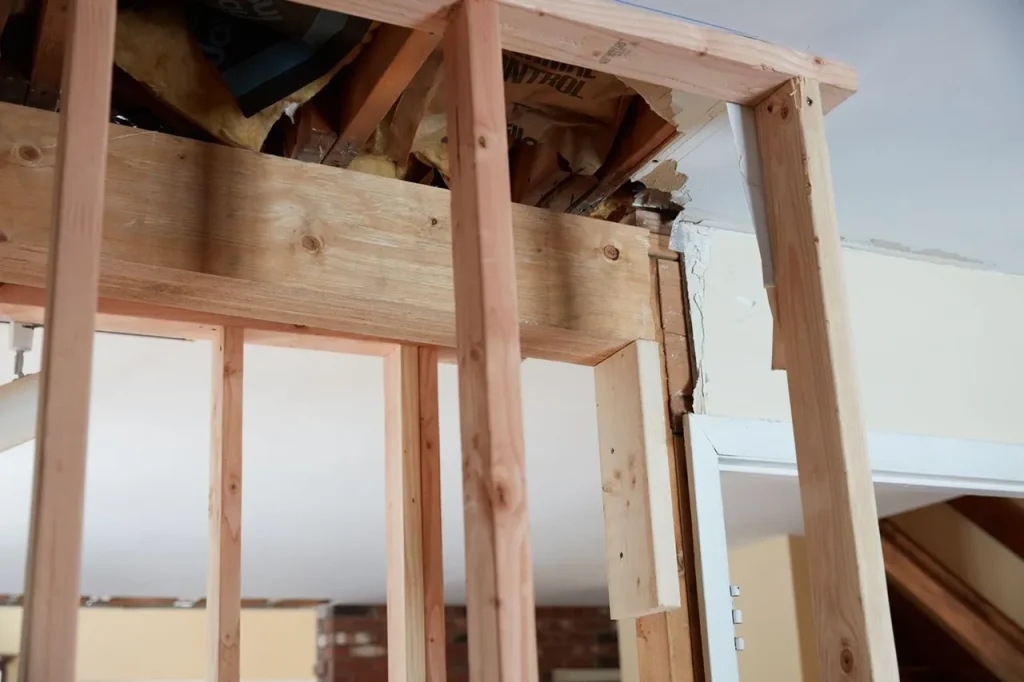Why would you choose to knock down a wall?
The removal of a wall in your home will make a significant contribution to both the beauty and the usefulness of the space. You may want to integrate your kitchen and dining room, expand the open space within your home, or let more natural light into the building. If you intend on making the most out of your money, learning the reason behind removing an internal wall will help you set priorities and carefully plan out the process.
Before you get started removing an interior wall in your home, here are some things to think about that you should take into consideration before you get started.
Is it a wall that bears the weight of the load or resist any lateral forces?
In most homes, load-bearing walls are built to support the ceiling or floor above them, as well as the roof of the building. The removal of these walls might cause the structure of the house to become compromised, which may result in the house collapsing or cracking.
A weight-bearing wall must be supported by a structural system such as beams, columns, or posts before it can be safely removed. This system will be constructed by a contractor before the wall in question is removed. These load-bearing beams or columns take the place of the load-bearing wall as the structural support for the building. The number of beams and columns that make up a wall will differ from one another according to the load that the wall was initially designed to bear.
In the interim, load-bearing walls are of utmost significance to the building, whilst non-load-bearing walls are not of any significance to the structure. The bulk of the time, the function of these walls is to demarcate the boundaries of the many rooms that are located on the floor. They are built with lighter materials to reduce the overall weight of the house’s construction, which is referred as as the “dead load.” It is possible to tear down these walls without in any way compromising the safety of the household in any way. Even if there are a few clues that can assist you in assessing whether or not an interior wall is capable of bearing weight, it is best to seek the guidance of a builder or an expert in order to be absolutely certain.
In addition, you should also find out if this wall is a lateral load resistant shear wall. Shear wall is a type of wall in structure to resist lateral force, such as seismic load and wind load. If the wall to be removed is a shear wall, then a new shear wall shall be introduced in the building system. Shear wall is the most important structure element in seismic region residential home structures.
The crew from Superb Engineer possesses all of the necessary knowledge and tools to remove a wall successfully and safely. Our highly trained engineers will locate load-bearing walls and shear walls, offer new structural supports, devise a strategy to relocate mechanical services, and help you simplify all operations.
What kinds of utilities can be found inside the wall cavity?
Before removing a wall, it is essential to inspect your house design to determine what is located within the wall cavity. The council may have the building plans on file and will be able to supply them to you for a fee if they do. You can also contact the former owner of the property or speak with your real estate agent to obtain a copy of the deed.
There is a possibility that the wall hollow contains ductwork for air conditioning and ventilation, as well as electrical wiring and plumbing. These are susceptible to damage, and the costs associated with repairs could be rather considerable. It’s possible that you’ll also need to shift them, which would require changing the walls that are near them. After demolishing a wall, you might be able to conceal protruding utilities by using a bulkhead that has been thoughtfully planned in some situations.
It is absolutely necessary to carefully plan the removal of the wall to avoid any accidents and unnecessary expenses.
Can you tell what kind of wall this is?
One last thing you need to think about is the kind of interior wall that you want to knock down. Compared to masonry, removing plasterboard attached to timber stud walls is simpler and less expensive. In comparison to the removal of a plasterboard wall, the removal of masonry walls may call for the utilization of heavy-duty demolition equipment and will take a longer amount of time to complete.
Your home’s interior walls may have asbestos-containing fibro cement sheeting if it is an older home. The age of your home will determine whether or not this is the case. Removing asbestos could result in additional fees for licensing and disposal, which would fall under the category of adding extra costs to the job. Mechanical Services
A partition can conceal a variety of utilities, including HVAC ductwork, plumbing, and electrical wire. Walls in a home with two stories and walls that are located near a bathroom are more likely to conceal these kinds of things. Because rerouting services that are discovered in the walls can add both time and money to the project, it is preferable to call in professional removal contractors for assistance in order to maintain the project on schedule and within its allotted budget.
Substances That Should Not Be Used
During the process of wall removal, the demolition of drywall is a dusty and dirty need that cannot be avoided. There is a possibility that it could present a significant risk to one’s health. Before 1980, asbestos was a common building material, and it is possible that older homes’ walls still contain some minerals.
In the process of demolition, hazardous asbestos fibers and clouds of drywall dust are released into the air. Both of these can cause irreparable damage to the health of those working on the demolition and those living in the home. The dangers to one’s health are not limited to asbestos. Lead paint, which was commonly used before 1978 and can be hazardous even at small levels, is another potential concern that can be found in older homes. Before removing drywall from a wall, a contractor is required to test the walls for asbestos and lead paint and then take precautions to limit their exposure to these hazardous materials. Before beginning with the removal of walls, removal specialists should always be consulted because it is possible that other dangerous compounds are present in the walls.



